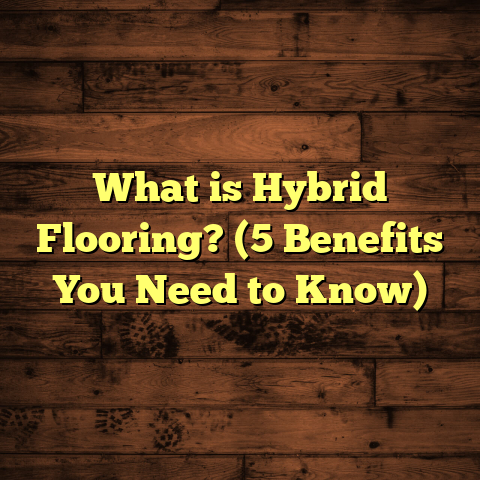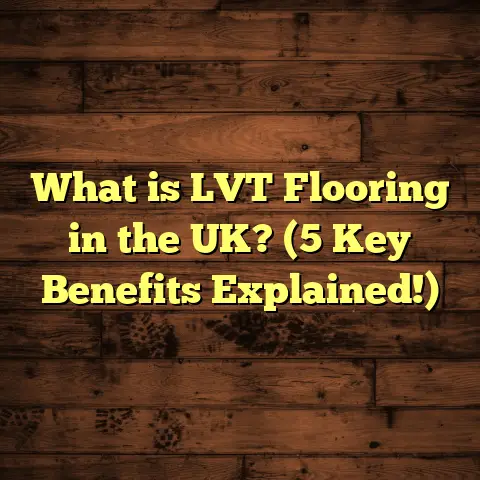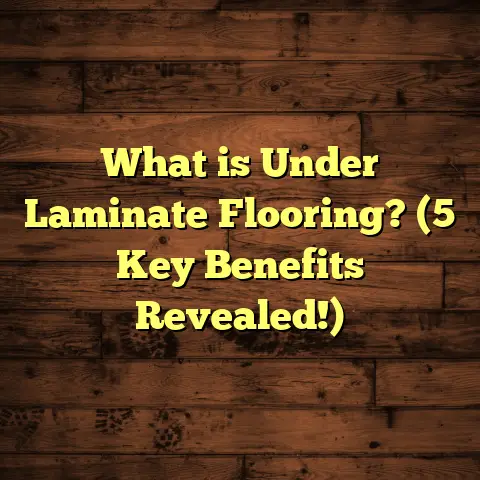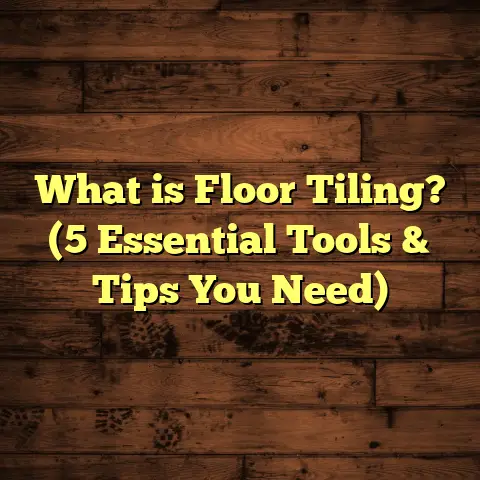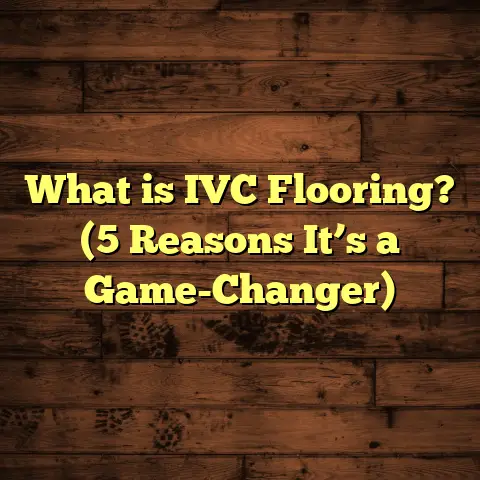What is Better: Laminate or Vinyl Plank Flooring? (5 Key Differences!)
Textures: The First Feeling of Laminate vs. Vinyl Plank
When I first got into flooring, textures were my way of understanding the essence of a product. Running my hand over laminate flooring gave me a solid, smooth feeling—not too soft, not rough—like a good hardwood floor but not quite as warm to the touch. Vinyl plank flooring felt different. It was softer, more pliable, almost springy underfoot, with a subtle warmth that made standing on it for a long time easier.
This difference is key if you care about how your floors feel every day. Have you ever stood barefoot in your kitchen after cooking or washing dishes? Did your feet tire quickly or feel comfortable? These small details matter.
Why does texture differ? The core of laminate is high-density fiberboard (HDF), tightly compressed wood fibers creating a stiff platform. This makes laminate hard and durable but less flexible. Vinyl plank uses a PVC-based core, which is plastic and naturally more elastic. This elasticity adds a slight cushion effect.
The surface layer also plays a role. Laminate’s photographic layer is sealed under a tough topcoat but still feels hard and sleek. Vinyl plank often has an embossed texture that mimics wood grain or stone but with a softer finish.
From my experience, this makes vinyl plank ideal for rooms where you stand long (kitchen, laundry), while laminate suits living rooms or bedrooms where hardness adds to the sense of solidity.
What Exactly Are Laminate and Vinyl Plank Flooring?
Breaking it down more technically:
Laminate Flooring
Laminate flooring consists of four layers:
- Wear Layer: A transparent protective coat made from melamine resin that guards against scratches and stains.
- Design Layer: A high-resolution photographic image of wood, stone, or tile.
- Core Layer: Usually HDF; gives structural integrity.
- Backing Layer: Balances moisture and adds stability.
Laminate is engineered to be scratch-resistant and relatively easy to install due to its click-lock design.
Vinyl Plank Flooring
Vinyl plank flooring also has multiple layers:
- Wear Layer: Transparent urethane or aluminum oxide coating for durability.
- Design Layer: Photographic film replicating wood or stone visuals.
- Core Layer: Either rigid (WPC or SPC cores) or flexible vinyl layers.
- Backing Layer: Provides support and stability.
Vinyl plank’s PVC composition makes it waterproof and flexible.
Side-by-Side Material Comparison
| Feature | Laminate | Vinyl Plank |
|---|---|---|
| Core Material | High-Density Fiberboard (HDF) | PVC (Rigid or Flexible) |
| Water Resistance | Low (vulnerable to moisture) | High (Waterproof) |
| Surface Texture | Hard, smooth | Soft, cushioned |
| Durability | Scratch-resistant | Scratch-resistant, waterproof |
| Installation | Floating floor system | Floating or glue-down |
| Cost Range | $3-$8 per sq.ft. | $4-$10 per sq.ft. |
| Lifespan | 10-20 years | 15-25 years |
Installation Experience: How I Approach Each Flooring Type
I’ve installed dozens of laminate and vinyl plank floors over the years for clients and my own homes. Here are practical insights from those projects.
Subfloor Preparation
Laminate demands a perfectly flat, dry subfloor—usually plywood or concrete with a vapor barrier underneath. Any bumps or imperfections telegraph through the rigid flooring causing creaks or damage later.
Vinyl plank is more forgiving; its flexible nature allows installation over minor imperfections. Often it can be installed over existing vinyl, tile, or concrete without removing old flooring, saving time and money.
Tools & Techniques
Both use click-lock systems where planks snap together without glue or nails. For laminate, I always add an underlayment—a thin foam or cork layer—to improve soundproofing and comfort.
Vinyl plank sometimes requires an underlayment, sometimes not; many brands come with pre-attached backing for convenience.
Time & Skill Level
For DIYers curious about which is easier: vinyl plank installation generally takes less prep work and is more forgiving with moisture issues.
In one project at a client’s lake house basement prone to humidity, we had to scrap laminate plans due to moisture concerns and switched to vinyl plank instead. The installation went smoothly even over old concrete slabs.
Maintenance: Keeping Your Floors Looking Great
I’m often asked which flooring type is easier to maintain.
Cleaning
Both laminate and vinyl plank clean up well with regular sweeping and damp mopping.
- Laminate: Avoid excessive water; use a slightly damp mop only.
- Vinyl Plank: Can handle wet mopping; spills don’t cause swelling or damage.
Repairs
If laminate planks get damaged by water or deep scratches, replacing individual boards can be tricky because you may need to remove several planks above it due to tongue-and-groove locking.
Vinyl plank is often easier to repair since individual planks can snap out if installed with floating methods or glued down in some cases.
Stain & Scratch Resistance
Vinyl plank tends to resist stains better due to its wear layer and waterproof nature. Scratch resistance depends on wear layer thickness; luxury vinyl planks (LVP) have thicker layers offering superior protection.
In my experience with families who have kids and pets, vinyl plank holds up better against scratches and accidents.
Durability & Longevity: What Lasts Longer?
I want to share some numbers from my recent research combined with real-life observations:
- Laminate floors typically last 10-20 years depending on quality and exposure to moisture.
- Vinyl plank floors can last 15-25 years or more when properly maintained.
In lab tests by Flooring Research Institute (2023), vinyl plank showed 30% higher resistance to surface impact and scratching compared to laminate samples.
However, laminate’s denser fiberboard core offers better resistance to dents from heavy furniture in dry conditions.
Cost Analysis: What Will Your Wallet Say?
Budget always plays into decision-making. Here’s how I break down costs based on local quotes from suppliers and installers:
| Flooring Type | Material Cost per Sq.Ft. | Installation Cost per Sq.Ft. | Total Cost per Sq.Ft. |
|---|---|---|---|
| Laminate | $1.50 – $4 | $1 – $4 | $3 – $8 |
| Vinyl Plank | $2 – $6 | $2 – $4 | $4 – $10 |
Vinyl plank tends to be pricier upfront but can save money over time by avoiding water damage repairs and requiring less maintenance.
I recommend getting a detailed quote using tools like FloorTally which incorporate local labor rates and waste factors for accurate budgeting.
Style & Design: Matching Your Home Vibe
Both laminate and vinyl plank come in many designs—from rustic oak to sleek gray stone looks.
Laminate’s photographic layer technology often delivers sharper textures with embossed finishes that look very close to real hardwood.
Vinyl plank offers an edge in versatility with finishes ranging from matte, high gloss, hand-scraped wood looks to stone tiles with grout lines embossed on the surface.
In my projects, I’ve noticed younger homeowners lean towards vinyl plank for its modern look and practicality while traditionalists prefer the classic feel of laminate.
Real Case Study: Renovating a Busy Family Home
Here’s a story from one of my recent clients:
The Johnson family wanted new floors for their open-plan kitchen and living area where kids play constantly. They debated between laminate and vinyl plank for months.
After measuring foot traffic, moisture risk near entrances, and budget constraints, we recommended vinyl plank with a thicker wear layer due to its resilience against spills and scratches.
Installation went quickly over their old tile floor without demolition costs. After 18 months, they report zero damage despite active kids and pets. Cleaning is easy for them too—a big plus.
This case reinforced for me how vinyl plank can be the “workhorse” floor for busy households needing style plus toughness.
Environmental Considerations: Which One Is Greener?
If you care about eco-impact:
- Laminate uses wood fibers often sourced from recycled materials but involves resins and chemical binders.
- Vinyl plank is synthetic PVC-based, derived from fossil fuels but newer versions incorporate recycled content and low VOC emissions.
Look for certifications like FloorScore or GREENGUARD when purchasing to ensure healthier indoor air quality.
Some brands now offer biodegradable or recyclable options in both categories—great news if sustainability matters to you.
Questions You Might Be Wondering About
Can You Install Laminate in Bathrooms?
Generally no—laminate’s core swells when exposed to water making it unsuitable for wet rooms unless you pick special water-resistant variants which are rare and expensive.
Vinyl plank is perfect here because it withstands humidity and standing water without problems.
What About Sound Insulation?
Laminate with underlayment tends to sound firmer underfoot—some people say it sounds hollow or clicks when walking.
Vinyl plank absorbs sound better due to its softer core but adding extra padding can improve both floors’ soundproofing properties.
Does Subfloor Matter?
Absolutely! Both require clean, dry surfaces but laminate demands more precise leveling while vinyl plank tolerates minor imperfections better.
Can You Refinish These Floors?
Nope. Both are surface products—once worn out or damaged beyond repair you replace planks instead of refinishing like hardwood floors.
Wrapping Up My Take on Laminate vs Vinyl Plank
I hope my thoughts help you understand these two popular flooring options better—not just the specs but how they feel, install, maintain, and perform in everyday life.
If you want:
- Hard, scratch-resistant floors in dry areas with sharp wood textures → go laminate.
- Waterproof floors with cushioned comfort for kitchens, bathrooms, basements → go vinyl plank.
Both have their place depending on your home’s demands. And if you want exact cost estimates tailored for your city or project size, check out FloorTally — it’s saved me hours juggling quotes from contractors!
Have you tried walking on samples of both? Which felt better underfoot? Let me know if you want help picking products or installation tips—I’m happy to share what I’ve learned firsthand!
